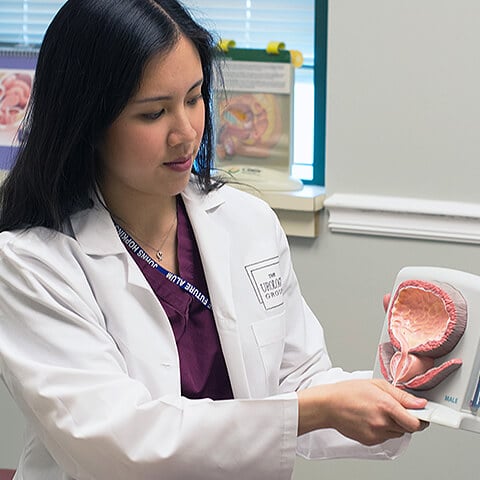Prolapse Detection and Diagnosis
Common causes and symptoms of pelvic organ prolapse may be the sensation of a mass bulging from the vaginal region and a feeling of pelvic heaviness as well as vaginal irritation. The prolapse may occur at the level of the bladder bulging through the vagina or the rectum bulging through the bottom floor of the vagina. For that reason, we describe it as a herniating process through the vaginal wall. Once the symptoms are established, a proper history and physical should be obtained from a specialized physician/surgeon.
Common causes we know are pregnancy, especially with vaginal childbirth. Vaginal childbirth increases a woman’s risk of prolapse as well as urinary incontinence greater than an elective C-section. An emergency C-section would then cause a risk factor three times higher in terms of urinary incontinence as well as vaginal vault prolapse.
The collagen-type tissue within the patient’s pelvis is a known cause of a patient being prone to vaginal vault prolapse as well as urinary incontinence. Menopause as well as previous surgery, obesity, aging, genetics, chronic coughing, chronic asthmatic conditions, as well as chronic lifting may also be a cause. Other symptoms besides the bulge sensation from the vagina may be a pulling or stretching feeling in the groin, painful sexual intercourse, as well as vaginal bleeding or spotting in addition to urinary/ fecal incontinence and difficulty with bowel movements. Colorectal surgeons commonly perform defecography studies and manometry studies to further evaluate this process.
Pelvic Organ Prolapse includes:
- Cystocele: bladder herniation through the upper vaginal wall.
- Rectocele: rectum bulging through the lower vaginal wall.
- Enterocele: bowel bulging through the deep vaginal wall.
- Uterine prolapse: uterus falling into the vaginal wall.
Cyctocele, Rectocele and Enterocele
A cystocele is the bulging of the bladder through the anterior portion of the vagina, and a rectocele is the rectum bulging through the posterior portion of the vagina. The apical wall, the deepest portion of the vagina, may also have some descent, and this is called uterine prolapse or an enterocele.
Treatment Options
Different forms of treatments for POP may be conservative management or surgical treatment.
Pessaries are conservative management but are still foreign bodies and do offer risk factors, such as bleeding, erosion, and fistulas.
Surgical repair is extremely successful, especially now that grafts are being offered, including kits which may decrease recurrence 3-10% looking at 3-5 years after surgery. Grafts may be used, including cadaveric material that has been processed, as well as porcine grafts. Synthetic graft materials are quite successful for treating hernias and vaginal vault prolapse. Kits may be available to add extra support in a “hammock-like” fashion. These have become quite popular and should only be placed in individual cases.
Hormone replacement with estrogen creams have been found to significantly improve patient tissue quality if taken 4-6 weeks prior to surgery. The topical creams theoretically do not offer the same degree of risk factors as systemic conjugated estrogens by mouth, and no studies have been shown to demonstrate the same degree of affect in terms of risk factors; however, all risk factors should be discussed and known by the patient in terms of any hormone replacement therapy.
More involved surgical repairs are found to be quite successful, including sacrospinous ligament repairs, uterosacral ligament repairs, as well as abdominal sacral colpopexies which may be done open, robotically, or laparoscopically.
Risk factors do exist for these surgeries. There still exists a risk of bleeding, infection, pain, and perforation of nearby organs. These areas maybe repaired or identified long after surgery. But the far majority of these prolapse repairs most commonly do quite well, and much success is experienced long-term. Pain and symptoms after surgery are transient and typically resolve within a month, if they do occur.
Although pelvic organ prolapse, as well as urinary incontinence is very bothersome and socially embarrassing, it should be established that these conditions could be successfully treated and surgically repaired. Pelvic Floor issues should be addressed in order to prevent long-term problems in the future. No form of treatment is a 100% guarantee to solve the occurrence of a pelvic floor disorder; however, obtaining relief and a degree of improvement can significantly improve one’s quality of life.
Leslie's Story: Uterine Prolapse
Print Page




